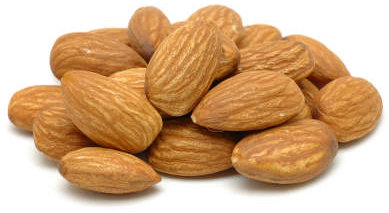

Almonds

Closely allied to the peach, the almond (Prunus dulcis, synonym Prunus amygladus) is a native of Asia Minor and parts of North Africa, including the Barbary Coast and Morocco. It was known in Biblical times. In the correct climate, the tree (3-8m high depending on cultivar) produces attractive early pink or white blossom and a valuable crop of nuts which are enclosed in a hard green hull. It has a comparatively low chilling requirement but the earliness of flowering (early spring or even late winter in some seasons) predisposes the blossom and fruitlets to frost damage and restricts successful commercial cultivation to comparatively few favoured regions, notably those bordering the Mediterranean and parts of Southern Australia and California. A considerable range of cultivars are available, most of which require a suitable pollinator alongside. There are two distinct types of almond: the sweet almond, which has pink flowers, and the bitter almond, purportedly with white petals, pink at the base, but more usually distinguished by fruit characters. The nuts of the former are highly prized as a food with many varied uses, while the bitter almond, which has a poisonous kernel, is used in the production of flavourings and for medicinal purposes. The British climate is unsuited to the production of almonds; even as a flowering tree the ravages of peach leaf-curl disease and the possible depredation by bullfinches in winter make it often less than satisfactory. Well-drained soil is essential. Almond seedling rootstocks are preferred for hotter, drier localities, peach stock for heavier soils. Trees are normally trained as open-centred bushes much as for plum, and should be planted by mid-winter. Pruning is restricted to removal of some of the oldest wood in favour of young wood in summer. Nutrition should follow that for peaches, adequate nitrogen being important. Weeds must be kept under control. Since the casing or hull enclosing the nut may crack, the nuts should be picked or (commercially) shaken from the tree, extracted cleanly and allowed to dry thoroughly before storing. propagation is normally by budding. Recommended cultivars include ‘All-in-One’, nuts sweet, self-fertile, ornamental with snowy white flowers; ‘Butte’, medium-sized nuts: ‘Carmel’, good quality, early cropping; ‘Garden Prince’, medium-sized nuts, sweet, self-fertile, good in containers; ‘Mission’, nuts rather bitter, flowers and crops late; ‘Ne Plus Ultra’, large flat nuts, flowers early; ‘Nonpareil’, nuts sweet, kernels very thin: most important commercial cultivar in US; ‘Padre’, plump kernels, crops well; ‘Peerless’, nuts very large, crops large and regular, quality medium, early-blooming; ‘Price’, nuts very sweet, soft-shelled, heavy cropper. 
Almonds can be affected by diseases which attack Prunus species and other trees, inlcuding armillaria root rot (Armillaria species), bacterial canker (Pseudomonas mors-runorium), brown rot (Sclerotinia fructigena), leaf curl (Taphrina deformans), plum rust (Tranzschelia pruni-spinosae), shot hole (Stigmina carpophila or physiologic causes), silver leaf (Chondrostereum purpureum) and white root rot (Rosellinia necatrix). Growing trees are subject to attack by many of the pests that attack peach trees. Almond nuts may become invaded by caterpillars of the almond moth (Ephestia cautella), a cosmopolitain pest of stored almonds, and the navel orange worm, Amyelois transitella in North America, which also infests stored almonds as well as attacking the crop in the field, although it can only gain access after the husks crack.
|
Home
Grow Herbs
Grow Fruit
Grow Vegetables
Cyberian Index
If you like this website and want one of your own contact
Cyberian All information correct at
time of publication and open to updates as necessary. No part of this website,
or its vectors, may be produced in any shape or form, using any type or design
of medium, system, equipment or otherwise without the prior written consensual
notice of the Cyberian. Any breach of these requirements will result in the
appropriate action. If in doubt, e-mail contact is recommended.
Some components of this website were obtained as open-source software and are
used in the same non-profit manner on this website.